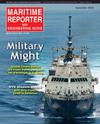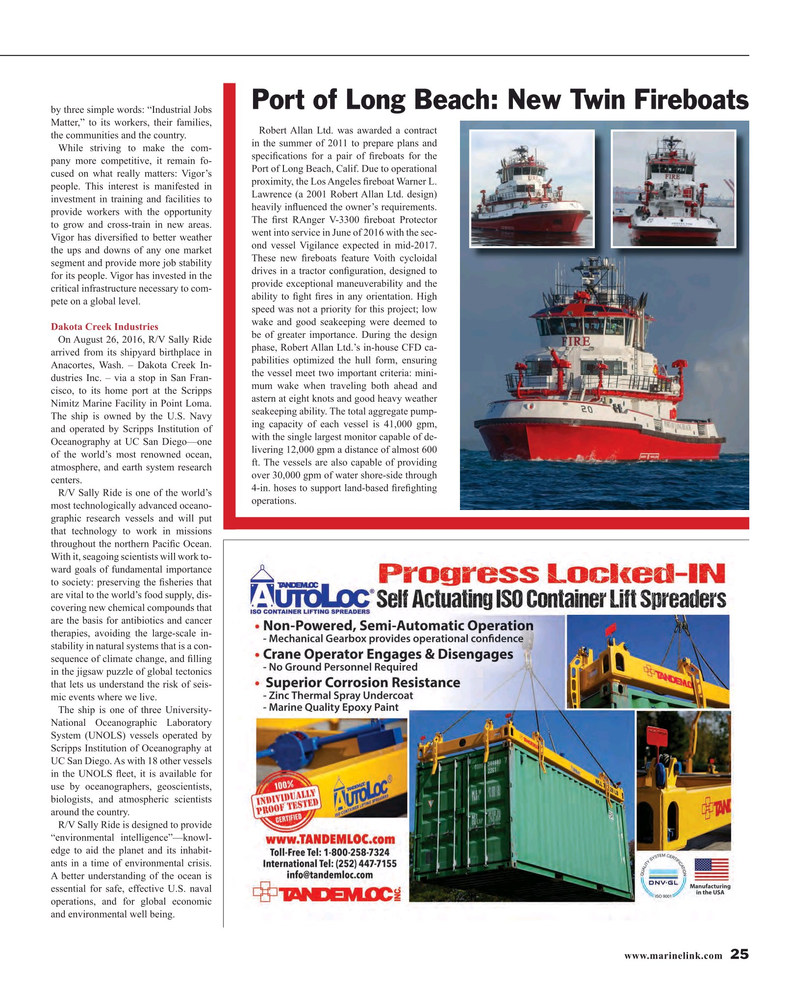
Page 25: of Maritime Reporter Magazine (September 2016)
Maritime & Ship Security
Read this page in Pdf, Flash or Html5 edition of September 2016 Maritime Reporter Magazine
Port of Long Beach: New Twin Fireboats by three simple words: “Industrial Jobs
Matter,” to its workers, their families,
Robert Allan Ltd. was awarded a contract the communities and the country. in the summer of 2011 to prepare plans and
While striving to make the com- speci? cations for a pair of ? reboats for the pany more competitive, it remain fo-
Port of Long Beach, Calif. Due to operational cused on what really matters: Vigor’s proximity, the Los Angeles ? reboat Warner L. people. This interest is manifested in
Lawrence (a 2001 Robert Allan Ltd. design) investment in training and facilities to heavily in? uenced the owner’s requirements. provide workers with the opportunity
The ? rst RAnger V-3300 ? reboat Protector to grow and cross-train in new areas. went into service in June of 2016 with the sec-
Vigor has diversi? ed to better weather ond vessel Vigilance expected in mid-2017. the ups and downs of any one market
These new ? reboats feature Voith cycloidal segment and provide more job stability drives in a tractor con? guration, designed to for its people. Vigor has invested in the provide exceptional maneuverability and the critical infrastructure necessary to com- ability to ? ght ? res in any orientation. High pete on a global level. speed was not a priority for this project; low wake and good seakeeping were deemed to
Dakota Creek Industries be of greater importance. During the design
On August 26, 2016, R/V Sally Ride phase, Robert Allan Ltd.’s in-house CFD ca- arrived from its shipyard birthplace in pabilities optimized the hull form, ensuring
Anacortes, Wash. – Dakota Creek In- the vessel meet two important criteria: mini- dustries Inc. – via a stop in San Fran- mum wake when traveling both ahead and cisco, to its home port at the Scripps astern at eight knots and good heavy weather
Nimitz Marine Facility in Point Loma. seakeeping ability. The total aggregate pump-
The ship is owned by the U.S. Navy ing capacity of each vessel is 41,000 gpm, and operated by Scripps Institution of with the single largest monitor capable of de-
Oceanography at UC San Diego—one livering 12,000 gpm a distance of almost 600 of the world’s most renowned ocean, ft. The vessels are also capable of providing atmosphere, and earth system research over 30,000 gpm of water shore-side through centers.
4-in. hoses to support land-based ? re? ghting
R/V Sally Ride is one of the world’s operations.
most technologically advanced oceano- graphic research vessels and will put that technology to work in missions throughout the northern Paci? c Ocean.
With it, seagoing scientists will work to- ward goals of fundamental importance to society: preserving the ? sheries that are vital to the world’s food supply, dis- covering new chemical compounds that are the basis for antibiotics and cancer therapies, avoiding the large-scale in- stability in natural systems that is a con- sequence of climate change, and ? lling in the jigsaw puzzle of global tectonics that lets us understand the risk of seis- mic events where we live.
The ship is one of three University-
National Oceanographic Laboratory
System (UNOLS) vessels operated by
Scripps Institution of Oceanography at
UC San Diego. As with 18 other vessels in the UNOLS ? eet, it is available for use by oceanographers, geoscientists, biologists, and atmospheric scientists around the country.
R/V Sally Ride is designed to provide “environmental intelligence”—knowl- edge to aid the planet and its inhabit- ants in a time of environmental crisis.
A better understanding of the ocean is essential for safe, effective U.S. naval operations, and for global economic and environmental well being.
www.marinelink.com 25
MR #9 (18-25).indd 25 9/6/2016 11:02:59 AM

 24
24

 26
26
